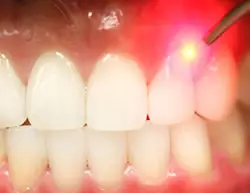Laser Dentistry
Discover the future of dental care with Green Dental’s cutting-edge laser dentistry services. Embrace a more comfortable and efficient dental experience as lasers replace traditional tools in various treatments.
From painless cavity fillings to precise gum reshaping, our dental clinic in Sherman Oaks uses advanced laser technology to ensure optimal results and faster healing. Say goodbye to anxiety and hello to a new era of dental care with our state-of-the-art laser dentistry, making your visits a breeze and your smile brighter than ever.
It involves the use of lasers to treat dental problems, from tooth decay and gum disease to cavities and root canal treatments. The benefits of laser dentistry are numerous, but include:
- Less bleeding during and after procedures
- No cuts or stitches
- Less swelling
- Less post-operative pain
- Speedy healing
- Fewer visits to the dentist Lasers
In 1990, the FDA deemed laser dentistry safe for public use. Since then, more and more dental practitioners have been investing in this technology. Lasers are used for various dental procedures, including teeth whitening, gum reshaping, and teeth cleaning.
Today’s dental lasers make tooth cleanings and fillings much less painful. Many dentists have incorporated dental lasers into everyday procedures – reducing bleeding, anxiety, and post-treatment recovery times.

Here are some of the other benefits associated with laser dentistry:
- Quicker healing & tissue regeneration.
- Preservation of more of the natural tooth.
- Reduced bleeding during and after treatment.
- Reduced need for anesthesia.
- Reduced need for stitches and sutures.
- Reduced risk of bacterial infections after procedures.
How can laser dentistry help me?
Laser dentistry has become a very versatile and important tool in modern dentistry. Dentists are using lasers to perform a wide range of procedures including cavity preparation, oral surgery, gum disease treatment, root canal therapy and tooth whitening. There are also lasers that can be used to cut and shape teeth to help improve the aesthetics of a smile. Laser dentistry can be used for cosmetic purposes or for preventative measures.
The dental lasers can be used in the following ways:
- Tooth preparation – Before laser dentistry, a dentist would have to use a drill to prepare the cavity for a filling. Lasers are a great alternative to traditional surgery because they are less invasive and don’t require anesthesia. Lasers are now commonly used to kill bacteria around the surgical site and reduce post-operative infection. This is because lasers are better at killing oral bacteria than traditional scalpel blades. They also have a lower risk of damaging surrounding tissue.
- Reshaping soft tissue – Laser dentistry is a growing field because it’s minimally invasive and can dissolve soft tissue to expose more of the natural tooth (crown lengthening), reshape soft tissue to make “gummy smiles” more attractive, and remove uncomfortable soft tissue folds caused by denture wear.
- Frenectomy – Laser therapy has proven to be an effective tool for helping with speech and feeding problems.
- Tumor removal – In cases where a benign tumor has developed in the soft tissues of the mouth, dental lasers offer a swift and non-invasive method to eliminate them.
- Whitening – Lasers can greatly expedite the tooth whitening process by increasing the activity of the particles in the peroxide bleaching solution. During laser tooth whitening, laser light is directed at your teeth. This light is absorbed by the chromophores (pigments) in your teeth causing heat to be generated.
- Biopsy – Lasers can be used to perform a biopsy on suspicious areas of soft tissue. A biopsy is a procedure where a sample of cells is removed from your skin and then sent to a laboratory for analysis.
How are laser procedures performed?
In fact, there are various types of dental lasers specifically developed to address different conditions. For instance, the Erbium-doped YAG laser is utilized for treating tetracycline staining and yellowing. It is crucial to comprehend which laser is most suitable for your skin type and the particular concern you wish to target.
In general, lasers with longer wavelengths have the ability to penetrate the skin more deeply. The commonly used dental lasers include carbon dioxide lasers and diode lasers, which are typically utilized for treating soft tissue issues.
The laser beam is extremely bright, and special glasses will be provided to protect the eyes. The dentist will then direct the beam at the affected area and carefully dissolve the soft tissue, harden the filling or whiten the teeth.
The laser dentistry procedure requires significantly less time compared to traditional methods, causing minimal anxiety and discomfort. Moreover, it offers a higher level of precision compared to many other techniques, increasing the likelihood of patients achieving their desired results through laser dentistry.
One main disadvantage of laser dentistry is its comparatively higher cost in comparison to traditional methods. Nonetheless, if you are experiencing significant pain or inflammation due to gum disease, laser dentistry offers an outstanding solution to alleviate symptoms and enhance the aesthetics of your smile.
